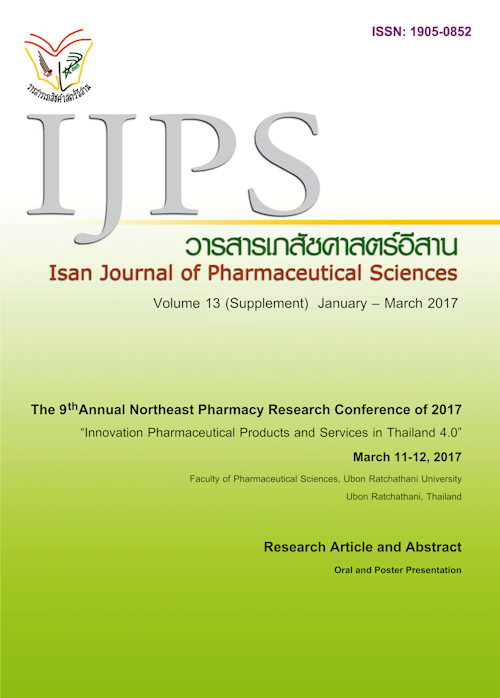Medicinal Use of Cannabis
Main Article Content
Abstract
Introduction : Cannabis has been used as a medicine for a long time. While Thailand marijuana as a drug to a Category 5. The aim of this review was to evaluate the evidence for the medical use and adverse event of cannabinoids. Methods : To conduct 2 Thai Herbal Medicine is 2Textbook of Medical Aid5 (Pat-Sard-Song-Kraw) and 2Lord Vishnu texts Dispensary5 (Pra-Osoth-Pra-Naray). In part of Modern Medicine, Systematic Review were searched from Pubmed and Cochrane Library from October 1992 to March 2016. Results: There were 11 formulations in Pat-Sard-Song-Kraw and 3 formulations in Pra-Osoth-Pra-Naray. The main indications are pain, sleep and appetite. In part of modern medicine, there was moderate-quality evidence to support the use of cannabinoids for the treatment of chronic pain and spasticity. Cannabinoids in medical use compose of nabiximol, nabilone, tetrahydrocannabinol/cannabidiol and dronabinol. Conclusions: "Cannabis" is a herb that has medical benefits with evidences from both traditional medicine and modern medicine. The major indications are chronic pain and multiple sclerosis. The side effects of marijuana in the short term are mild; however, the long term side effects are unclear.
Article Details
In the case that some parts are used by others The author must Confirm that obtaining permission to use some of the original authors. And must attach evidence That the permission has been included
References
Borgelt L, Franson K, Nussbaum A, Wang G. The pharmacologic and clinical effects of medical cannabis. Pharmacotherapy 2013 Feb; 33(2): 195-209.
Brenneisen R. Chemistry and analysis of phytocannabinoids and other cannabis constituents. In:
Carlos F, Rocha M, Guilherme J, et al. Systematic review of literature on clinical and experimental trials on the antitumor effects of cannabinoids in gliomas. J Neurooncol 2014 (116) :11-24.
Hazekamp A, Ware MA, Muller-Vahl KR, Abrams D, Grotenhermen F. The medicinal use of cannabis and cannabinoids-an international cross-sectional survey on administration forms. J Psychoactive Drugs. 2013; 45(3): 199-210.
Kano M. Control of synaptic function by endocannabinoid-mediated retrograde signaling. Proc. Jpn. Acad., Ser. B Phys Biol Sci 2014; 90 (7): 235-250.
Kramer JL. Medical Marijuana for Cancer .CA Cancer L Clin 2015 (65): 109-122
Leelawat S, Leelawat K, Narong S and Matangkasombut O. The Dual Effect of ٨9- Tetrahydrocannabinol on Cholaniocarcinoma Cells: Anti-Invasion Activity at Low Concentration and Apoptosis Induction at High Concentration. Informa Healthcare; Cancer Investigation 2010, (28): 357-363.
Moher D, Shamseer L, Clarke M, et al. Preferred reporting items for systematic review and meta-Analysis protocols (PRISMA-P) 2015 statement. Systematic Reviews. 2015;4(1):1.
Office of National Drug Control Policy. Marijuana Resource Center: State Laws Related to Marijuana. https://www.whitehouse.gov/ondcp/state-laws-related-to-marijuana. Accessed May 18,2015.
Picheansoonthon C, Chawalit M, Jeerawong W. Explanation Lord Vishnu texts Dispensary (Pra-Osoth-Pra-Naray) Volume celebration 72 year maharajah 5 DEC 1999 r2001: 5, 34, 37, 99-100, 107, 207-209.
Prapaspong B, et al. Textbook of Medical Aid5(Pat-Sard-Song-Kraw): Medical wisdom and literary Heritage of the nation. Bangkok: Thailand Language Department of the Ministry of Education., 1999.
Rujanathamrong P, Management of Krathom and Marijuana for Medicine and Health, social security, Thailand. (Conference proceedings 27 Sep 2016)
Samkosed W. Marijuana is cute (Online). 2013 Aug 27 (cited 2016 Oct 14); Available from http://www.bangkokbiznews.com/blog/detail/525156
United Nations. Single Convention on Narcotic Drugs, 1961. New York, NY: United Nations; 1962.
Wang T, Collet JP, Shapiro S, Ware M. Adverse effects of medical cannabinoids: a systematic review. CMAJ 2008 Jun 17; 178(13): 1669-1678
Whiting PF, Wolff S, Deshpande S, et al. Cannabinoids for Medical Use A Systematic Review And Meta-analysis. JAMA 2015 Jun 23; 30(313): 2456-2473.


